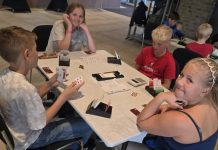- Do one thing at a time.
- Count points or distribution—don’t do both at once.
- Count initial pattern or remaining suit length, don’t do both at once.
- Finish one task before starting the next. E.g., suppose you count the opener’s distribution, before switching to placing HCP, count partner’s distribution too.
- Start with facts, then move to hypotheses.
- For example, you hold 7 HCP. Dummy tables with 9 HCP. You can see 16 HCP—that is fact.
- If opener’s bidding showed 12–14, that is a hypothesis. Openers sometimes lie and hold 11 or 15.
- Declarer ruffs the second round of a suit. The singleton is a fact. As a defender, you can now identify the original layout of that suit with certainty.
- Declarer bid clubs late in the auction. Declarer may have 4, but may not. The assumption he holds 4 is a hypothesis, not a fact
2. Minimize the math. For example: (1NT) – P – (3NT) – All Pass.
You hold 7 HCP. Dummy tables 10, for 17 visible HCP. Assume the 1NT opening promised 15–17. One counting option:
- add 17 to 15 for 32 known points.
- 40–32 = 8 points (partner’s maximum)
- 8–2 = 6 points (partner’s minimum)
A better option produces less math and less chance for mental errors.
- add 17 to 16 (middle of the range) for 33 known points.
- 40–33 = 7 points
- Partner holds 7 points +/- 1
3. After counting the points of one unseen hand, pick the weaker of the two unseen hands, then mentally convert their points to high honor.
- I.e., 7 HCP is equal to two high honors, Ace and king, two kings and a jack, etc.
- Eliminate suits where between your hand, dummy’s hand and any cards already shown, partner can not hold a high honor in the suit,
- Now identify which specific high honors are possible. Frequently, there are few options.
- When you can place honors in the weak hand, mentally note that the remaining honors are in the other hand.
I have three things that help me:
Try thinking in terms of patterns instead of counting. So rather than counting to 13 spades in play, try to think in terms of 4-4-3-2 or 5-4-2-2 or 6-3-3-1. These pattern of numbers that add to 13 come up a lot for both the distribution of the 4 suits in your hand (or in an opponents hand), and also for how each suit is split amongst the 4 players. Moreover, the probability of each pattern is the same for each usage so as you see how often you hold each pattern that can help you learn how likely each pattern is relative to other “possible” patterns.
When trying to remember things, don’t fixate on just remembering the card. Instead ask yourself “What is going on?” and “What does that mean?”. It is easier to remember a high spot lead in spades probably means that my LHO has 2 or 1 and is looking for the ruff, than it is to remember the LHO lead the S8 (or whatever) by just focusing on the S8.
To remember the opening lead I like to write it down in my personal score sheet along with the contract. This is useful in the post-mortem, but the act of pausing to note the lead and write it down helps me remember it (of course I don’t look at the writing during the play of the hand, that would be cheating, but just having written D7 helps remember).
Answer Number 3:Radu Zoran, Bridge player
I don’t really have much to add to Michael Bodell‘s answer except perhaps that you should never forget to count the outstanding trumps when declaring. It can be extremely embarrassing when you have a hand all but figured out and an opponent ruffs you with a trump you didn’t expect.
You do have to count in this game, but 99% of bridge players can’t remember each and every card played and when it was played, so it’s best to focus on the important suit(s) and ask yourself: What cards (honours) are missing? Where can they be? What clues do I have from the bidding and opening lead?
Always take at least 10 seconds to think at trick one. Use this time to “take a picture” of the cards you see and make your plan (when declaring) or think about how the play could go (when defending).
Another trick I use is to focus on the remaining cards. You can think of a Bridge hand as trying to mentally reconstruct a puzzle, where the cards played are no longer important and you can free your memory of them (this also works with regard to deals played).
As a bonus, this Counting Game is a useful tool to test and practice your pattern recognition skills. Have fun!
Answer Number 4: Will Watson
It is very difficult to memorize every card played. It is also not necessary. Instead remember what signals were played. If an opponent plays a card that looks likely to show an even number because it is high note that the defender played the 8 suggesting an even number. If you forget the exact value 8, it is often still easy to remember that a large card suggesting an even number was played. This idea is true in general. If you see a small card that discourages don’t try to remember that the 3 was played. Try to remember that the person on your right discouraged spades by playing the 3. Finally pay special attention to discards, again remembering what they mean.
In conclusion if the cards mean something to you it will be easier to remember what happened. And if you don’t remember the exact card you are still likely to know what is important to play accurately.
Don’t forget to follow us @



























